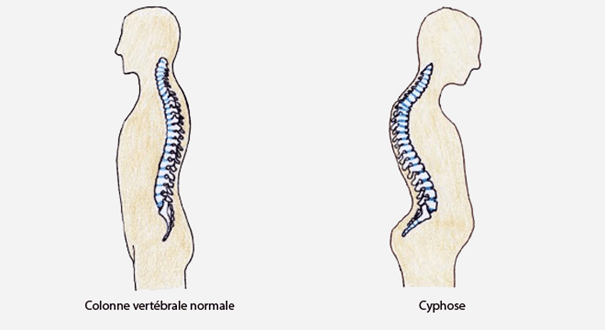Contents
Maladie de scheuermann
What is it ?
Scheuermann’s disease refers to a condition of the vertebrae linked to the growth of the skeleton that causes deformation of the spine, kyphosis. This disease, which bears the name of the Danish doctor who described it in 1920, occurs during adolescence and gives a “hunchbacked” and “hunched” appearance to the affected person. It affects children aged 10 to 15, more frequently boys than girls. The lesions caused to the cartilages and vertebrae are irreversible, although the disease stops progressing at the end of growth. Physiotherapy helps the affected person to maintain their motor skills and surgery is only possible in the most severe forms.
Symptoms
The disease is often asymptomatic and is discovered incidentally on an x-ray. Fatigue and muscle stiffness are usually the first symptoms of Scheuermann’s disease. Symptoms appear mainly at the level of the lower part of the dorsal spine (or thoracic spine, between the shoulder blades): exaggerated kyphosis occurs with the growth of bones and cartilage and an arched deformation of the spine appears, conferring to the affected person a “hunchbacked” or “hunched” appearance. One test is to observe the column in profile as the child leans forward. A peak shape appears instead of a curve at the lower part of the thoracic spine. The lumbar part of the spine can also become deformed in its turn and scoliosis occurs, in 20% of cases, causing more intense pain. (1) It should be noted that neurological signs are rare, but not excluded, and that the pain caused is not systematically proportional to the curvature of the spine.
The origins of the disease
The origin of Scheuermann’s disease is currently unknown. It could be a mechanical response to injury or repeated trauma. Genetic factors could also be at the origin of bone and cartilage fragility. Indeed, a familial form of Scheuermann’s disease directs researchers towards the hypothesis of a hereditary form with an autosomal dominant transmission.
Risk factors
The sitting posture with the back bent should be avoided as much as possible. Thus, the person suffering from the disease should prefer a non-seated profession. Sport is not to be banned but is an aggravating factor if it is violent and traumatic for the body in general and the back in particular. Gentle sports such as swimming or walking should be favored.
Prevention and treatment
Treatments for Scheuermann’s disease consist of relieving the spine, controlling its deformation, improving the posture of the affected person and, ultimately, reducing the injuries and pain caused. They should be implemented as early as possible during adolescence.
Occupational therapy, physiotherapy and ultrasound, infrared light and electrotherapy treatments help reduce back pain and stiffness and maintain good motor skills in the upper and lower limbs. In addition to these conservation measures, it is also a question of applying forces to try to stretch the kyphosis when the growth is not completed: by strengthening the muscles of the back and abdominals and, when the curvature is important , by wearing an orthosis (a corset). Straightening of the spine by surgical intervention is only recommended in severe forms, that is to say when the curvature of the kyphosis is greater than 60-70 ° and previous treatments have not made it possible to relieve the person.










